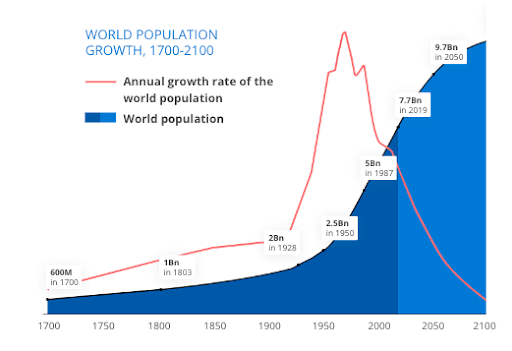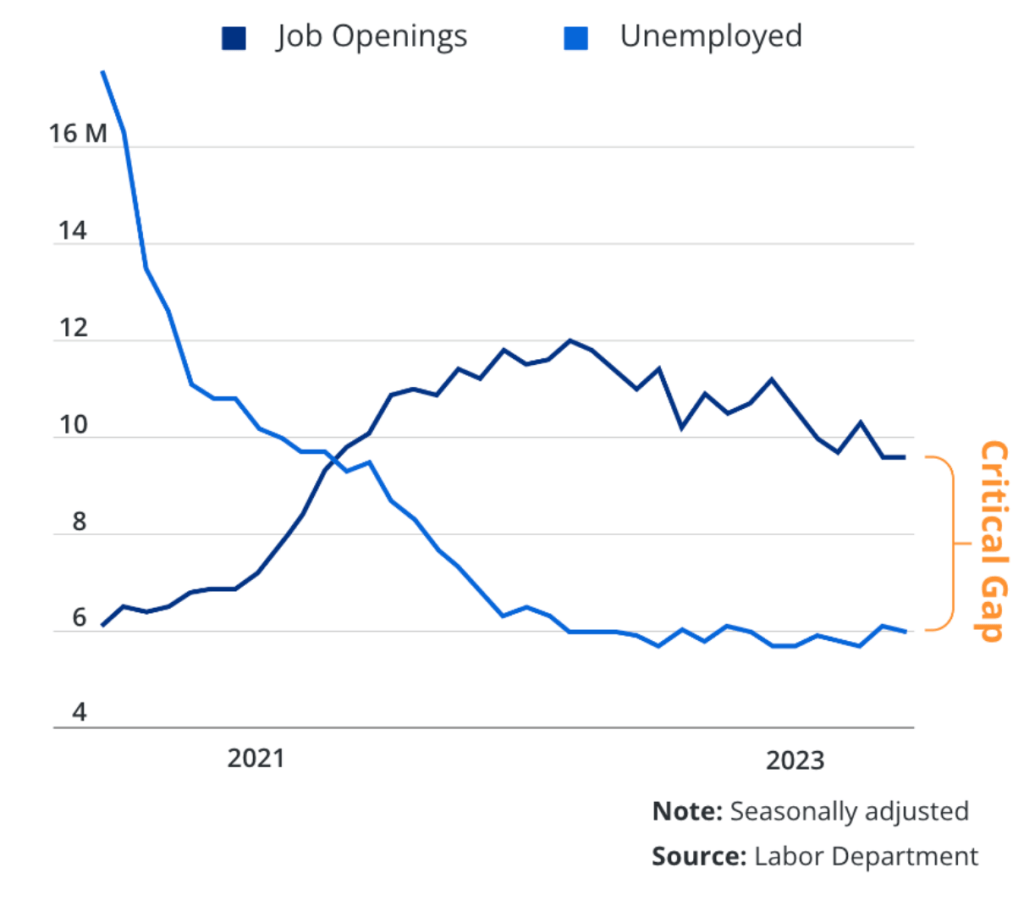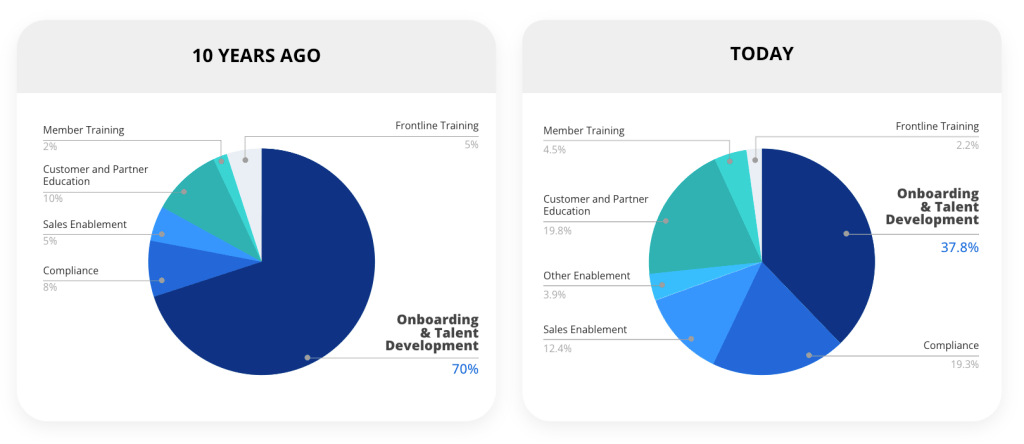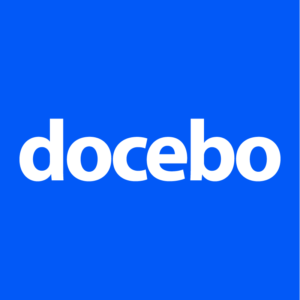How AI-Powered Learning Is Shaping The Future
AI adoption is surging across industries, with the use of generative AI (GenAI) doubling from 33% in 2023 to 65% in 2024. [1] Corporations are certainly embracing AI, but what if I told you that AI adoption isn’t just a trend but a survival strategy?
There are major forces at play, including population changes, labor shortages, rising employee expectations, and organizational transformation, all of which are set to drastically impact how people learn.
So it’s no wonder that 72% of businesses are using AI across various business areas. [1] Incorporating AI into learning holds the potential to enhance Learning and Development (L&D), too.
With hyper-personalized experiences that adapt within the flow of work, analytical insights, and seamless automation, AI-driven learning platforms are set to empower companies to address skill gaps and productivity challenges. But AI isn’t without risks.
Selecting the right AI-driven learning technology to engage employees and equip them for the future of work has become essential for organizations today.
The Challenges Facing Today’s Enterprises
Enterprises are facing a brave new world—one where global birth rates are steadily declining with an aging population about to retire. [2]
In other words, we’re losing more experienced workers than we can replace, leaving companies without the “tacit knowledge” built over years.

The annual growth rate of the world’s population is steadily declining. Source: UN Population Division
This tacit knowledge—the insights and expertise carried only in a person’s mind—is what separates an experienced worker from a novice. Now, with an entire generation leaving the workforce, enterprises are facing a brain drain. It’s like losing the recipe to your favorite family dish just before the holidays.
So, there are fewer workers to do the work, and now they also have to juggle learning about and working with AI. According to the World Economic Forum, 23% of jobs will be impacted by AI by 2027. [3] But the truth is we’re already impacted.

We’re losing experienced employees quicker than new workers can fill their roles. This significantly widens the skill gap as companies lose critical expertise and institutional knowledge. Source: US Bureau of Labor
Sixty-one percent of employees have tried AI at work at least once, and yet it’s highly likely the majority are learning on their own time. [4] Research performed by Docebo showed that 70% of workplace learning happens off the clock.
It’s a little like expecting an athlete to train and prepare on their own, and then, when the big game comes, perform flawlessly. And if they don’t? Well, they might start looking for a coach who’ll meet them where they are—during work hours.
Without opportunities to learn in the workplace, 67% of employees are more likely to switch to a new employer. [4] Upskilling has never been more important, and employees see it as a differentiator.
Today’s employees also have heightened expectations for meaningful work experiences, including personalized learning and development.
The corporate learning landscape is also expanding. Enterprises are investing in educating not just employees but also clients and partners—expanding their learning audiences beyond traditional boundaries.
Data from Docebo shows that companies have doubled their external training efforts. A recent study by Brandon Hall Group indicates that over half of organizations now offer learning to external, non-employee groups such as customers, channel partners, distributors, resellers, and franchisees. [5]

According to Docebo’s customer data, enterprises are also expanding learning use cases. In the span of ten years, many organizations have more than doubled their external training through customer education and partner enablement. Source: Docebo
How, then, can organizations adapt to these challenges?
The Role Of AI In Transforming Learning At Work
This is where AI-powered learning platforms could shine.
Imagine a world where the virtual assistant on your computer isn’t just guiding you through content but personalizing your entire experience. Advanced AI tools are cataloging, sorting, and suggesting the content you need most, much like Netflix serves up the next series to binge.
With AI-driven deep search and auto-tagging, learning materials are no longer buried; they’re just a click away.
Imagine the grind behind content creation: it can take over 100 hours to produce a single hour of training material. But with AI, this process speeds up dramatically. [6]
AI-driven analytics can pinpoint gaps in knowledge, allowing training to target real needs while also transforming that elusive tacit expertise into organized, searchable insights that foster collaboration.
Yet, AI isn’t flawless. Its decisions can be opaque, sometimes even “hallucinating” or mirroring biases.
That’s why a solution like Docebo’s, which takes a pedagogy-first approach, insists on AI that’s transparent, explainable, and reliable. Reflecting this commitment, Docebo partnered with TEDAI Vienna to explore AI’s transformative impact on society alongside global thought leaders.
Let’s explore how one company harnessed AI to redefine its approach through a case study.
Real-World Success With AI: The Booking.com Case Study
Before switching to Docebo’s AI-powered learning platform, Booking.com, one of the world’s leading digital travel companies, faced a mountain of manual work, from sending emails to managing calendars for over 15,000 employees.
With Docebo, however, Booking.com consolidated their tech stack, with integrations like Google Calendar and Workday, automating notifications and personalizing learning efforts.
The results? They scaled learning programs by 30% and increased Subject Matter Expert training by 40%, without causing strain to their administrative overhead. In fact, administrative time dropped by 80%, saving more than 800 hours annually.
Conclusion: The AI-Powered Future Of Learning
So, can AI truly bridge the gaps it sets out to fill? Yes—but there’s nuance. Like many innovations, AI holds immense potential for clarity, insight, and transformation. But it can also introduce biases. That’s why it’s critical to prioritize building AI systems that are inspectable, explainable, and open to human oversight.
One thing is certain: in the workplace of the future, AI isn’t just a tool. It’s a partner. And it will be essential for supporting employee development and addressing skill gaps, labor shortages, and the increased demands of today’s enterprises. By offering personalized, data-driven learning paths, AI will enable employees to learn within the flow of work, promoting both productivity and adaptability.
References:
[1] The state of AI in early 2024: Gen AI adoption spikes and starts to generate value
[2] Global fertility has collapsed, with profound economic consequences
[3] Why is the Reskilling Revolution needed?
[4] Global Workforce Hopes and Fears Survey 2024
[5] Hidden Opportunities in Extended Enterprise Learning
[6] How Long Does It Take to Develop Training? New Question, New Answers
















